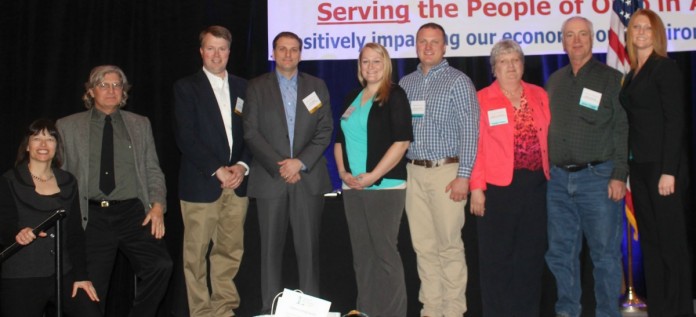COLUMBUS — Conservation is alive and well in Ohio.
That was the message at the Ohio Federation of Soil and Water Conservation District’s annual meeting held Feb. 22 and 23 in Columbus.
The Champions of Conservation honored several individuals and groups at the awards luncheon Feb. 23. But that wasn’t all attendees got to experience.
Successful event
Mindy Bankey, chief executive officer for the Ohio Federation of Soil and Water Conservation Districts, declared the conference a success.
She said the conference was a blend of education and honors for attendees, and ultimately districts will benefit from what board members and technicians learned at the event.
Education sessions
Sessions included such topics as cover crops, phosphorus run-off, forestry, stormwater, technology in the fields for farmers, and there was even a session called “breakfast on the farm.”
Last year, the Fulton SWCD brought the community to the farm for an agricultural experience. The Fulton SWCD brought over 3,000 people to a farm for breakfast and found out that over 50 percent of the event’s attendees had never been on a dairy farm.
Grazing management
One of the sessions taught by Bob Hendershot, a grazing specialist with the USDA- Natural Resources Conservation Service, about pasture soil health helped graziers learn more about why grazing animals are so important to improving the soil.
Hendershot said the world can’t have grasslands without grazing animals. The only known tool to heal the land, he explained, is animal impact — everything that livestock do to the land. This is not just manure, but hoof action and salivating.
Grazing actually adds biology, Hendershot said. Animals on pasture leave behind manure and saliva and young livestock even leave milk foam. Milk foam is what is often what is left on the animals muzzle after suckling from the mom. This all adds microbes to soil.
To keep their eye on profits, Hendershot said farmers need to match animals and their forage values.
Different stages of life depend on different feed values. Ewes with lambs or cows with a calf need a higher feed value than an animal not bred or those early in the gestation period.
Hendershot also recommends keeping the time of the year in mind as well as the animal and its life stage — different grass types and different time periods mean different feed values.
“Don’t guess — test,” said Hendershot.
He also urges graziers to keep the grazing area small, it helps minimize the number of places animals use for manure.
Cooperator of the Year
One of the big winners at the luncheon was Lohstroh Family Farms, named Farm Credit of Mid-America Cooperator of the Year. The farm concentrates on water quality, soil erosion establishing wildlife habit to education.
George and Michelle Lohstroh along with their children Jonathon and Annie, work to spread the conservation message.
To improve water quality and soil health, the Lohstrohs adopted controlled traffic practices to reduce compaction, use cover crops and no till to keep the soil microbes population up in the winter and increase the level of organic matter in the soil on their Mount Sterling, Ohio, farm.
The farming operation includes pumpkins, cattle, soybeans and corn. The family has also added the use of solar and geothermal energy to their operation.
The farm has used buffer strips along Deer Creek, fencing cattle out of the creek and streams and have worked to improve wildlife and pollinator habitat.
President’s Awards

The app, Ohio Nutrient Management Record Keeper or ONMRK, was released this fall and is available to download online, Google Play and the App Store. The App allows producers to record the information on their smartphone then transfer it and use it on their computers. The app has been dowloaded thousands of times already.
Individual award
Tia Rice earned the President’s Individual Award. Rice was a district administrator from Seneca Soil and Water Conservation District, who was diagnosed with cancer in July 2015 and died in October. Rice was known as a force to be reckoned with when it comes to conservation.
She worked to spread the message, not just in her district but across the state and even nationally at conferences.
Rice’s fiance and her daughter, Mike Thiel and Teahl Rice accepted the honor at the luncheon.
Supervisors honored
Two district supervisors were also honored at the conference. David Rohrer and Lawrence Burdell were both inducted into the Ohio Federation’s Supervisors Hall of Fame.
Rohrer became a Wayne SWCD supervisor in 1987 and served for 25 years. He is a fifth generation farmer, growing corn alfalfa, wheat and potatoes as well as raising Holstein cattle.

Education awards
The organization also honored three teachers for their work in natural resource education.
Janet Scruby and Julianne Elder, both teachers at South Lebanon Elementary in Warren County, were honored for their work in conservation.
The team of teachers work to add natural resource education into an environmental after-school science club called E-Club.
Tracy Hall is a teacher at Lehman High School in Shelby County. Hall incorporates watershed education into her curriculum and encourages high school students to explore the possibilities of conservation-related science fair projects.












